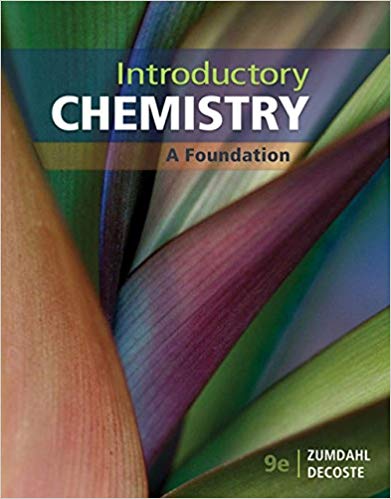This is completed downloadable of Solution Manual for Introductory Chemistry A Foundation 9th by Zumdahl

Product Details:
- ISBN-10 : 1337399426
- ISBN-13 : 978-1337399425
- Author: Steve Zumdah, Donald J. DeCoste
Succeed in your course with INTRODUCTORY CHEMISTRY: A FOUNDATION! This best-selling text combines enhanced problem-solving structure with substantial pedagogy to help you become a successful problem solver. Early coverage of chemical reactions, accessible explanations and visualizations, and an emphasis on everyday applications facilitates understanding. The authors� step-by-step approach has already helped hundreds of thousands of student’s master chemical concepts and develop strong problem-solving skills. Interactive study aids in OWLv2, such as ChemWork Problems and Adaptive Learning Activities, help students master concepts.
Table of Content:
- Chapter 1: Chemistry: An Introduction
- 1.1 Chemistry: An Introduction
- 1.2 What Is Chemistry?
- 1.3 Solving Problems Using a Scientific Approach
- 1.4 The Scientific Method
- 1.5 Learning Chemistry
- Chapter 1 Review
- Chapter 2: Measurements and Calculations
- 2.1 Scientific Notation
- 2.2 Units
- 2.3 Measurements of Length, Volume, and Mass
- 2.4 Uncertainty in Measurement
- 2.5 Significant Figures
- 2.6 Problem Solving and Dimensional Analysis
- 2.7 Temperature Conversions: An Approach to Problem Solving
- 2.8 Density
- Chapter 2 Review
- Chapter 3: Matter
- 3.1 Matter
- 3.2 Physical and Chemical Properties and Changes
- 3.3 Elements and Compounds
- 3.4 Mixtures and Pure Substances
- 3.5 Separation of Mixtures
- Chapter 3 Review
- Cumulative Review Chapters 1-3
- Chapter 4: Chemical Foundations: Elements, Atoms, and Ions
- 4.1 The Elements
- 4.2 Symbols for the Elements
- 4.3 Dalton’s Atomic Theory
- 4.4 Formulas of Compounds
- 4.5 The Structure of the Atom
- 4.6 Introduction to the Modern Concept of Atomic Structure
- 4.7 Isotopes
- 4.8 Introduction to the Periodic Table
- 4.9 Natural States of the Elements
- 4.10 Ions
- 4.11 Compounds That Contain Ions
- Chapter 4 Review
- Chapter 5: Nomenclature
- 5.1 Naming Compounds
- 5.2 Naming Binary Compounds That Contain a Metal and a Nonmetal (Types I and II)
- 5.3 Naming Binary Compounds That Contain Only Nonmetals (Type III)
- 5.4 Naming Binary Compounds: A Review
- 5.5 Naming Compounds That Contain Polyatomic Ions
- 5.6 Naming Acids
- 5.7 Writing Formulas from Names
- Chapter 5 Review
- Cumulative Review Chapters 4-5
- Chapter 6: Chemical Reactions: An Introduction
- 6.1 Evidence for a Chemical Reaction
- 6.2 Chemical Equations
- 6.3 Balancing Chemical Equations
- Chapter 6 Review
- Chapter 7: Reactions in Aqueous Solutions
- 7.1 Predicting Whether a Reaction Will Occur
- 7.2 Reactions in Which a Solid Forms
- 7.3 Describing Reactions in Aqueous Solutions
- 7.4 Reactions That Form Water: Acids and Bases
- 7.5 Reactions of Metals with Nonmetals (Oxidation-Reduction)
- 7.6 Ways to Classify Reactions
- 7.7 Other Ways to Classify Reactions
- Chapter 7 Review
- Cumulative Review Chapters 6-7
- Chapter 8: Chemical Composition
- 8.1 Counting by Weighing
- 8.2 Atomic Masses: Counting Atoms by Weighing
- 8.3 The Mole
- 8.4 Learning to Solve Problems
- 8.5 Molar Mass
- 8.6 Percent Composition of Compounds
- 8.7 Formulas of Compounds
- 8.8 Calculation of Empirical Formulas
- 8.9 Calculation of Molecular Formulas
- Chapter 8 Review
- Chapter 9: Chemical Quantities
- 9.1 Information Given by Chemical Equations
- 9.2 Mole-Mole Relationships
- 9.3 Mass Calculations
- 9.4 The Concept of Limiting Reactants
- 9.5 Calculations Involving a Limiting Reactant
- 9.6 Percent Yield
- Chapter 9 Review
- Cumulative Review Chapters 8-9
- Chapter 10: Energy
- 10.1 The Nature of Energy
- 10.2 Temperature and Heat
- 10.3 Exothermic and Endothermic Processes
- 10.4 Thermodynamics
- 10.5 Measuring Energy Changes
- 10.6 Thermochemistry (Enthalpy)
- 10.7 Hess’s Law
- 10.8 Quality versus Quantity of Energy
- 10.9 Energy and Our World
- 10.10 Energy as a Driving Force
- Chapter 10 Review
- Chapter 11: Modern Atomic Theory
- 11.1 Rutherford’s Atom
- 11.2 Electromagnetic Radiation
- 11.3 Emission of Energy by Atoms
- 11.4 The Energy Levels of Hydrogen
- 11.5 The Bohr Model of the Atom
- 11.6 The Wave Mechanical Model of the Atom
- 11.7 The Hydrogen Orbitals
- 11.8 The Wave Mechanical Model: Further Development
- 11.9 Electron Arrangements in the First 18 Atoms on the Periodic Table
- 11.10 Electron Configurations and the Periodic Table
- 11.11 Atomic Properties and the Periodic Table
- Chapter 11 Review
- Chapter 12: Chemical Bonding
- 12.1 Types of Chemical Bonds
- 12.2 Electronegativity
- 12.3 Bond Polarity and Dipole Moments
- 12.4 Stable Electron Configurations and Charges on Ions
- 12.5 Ionic Bonding and Structures of Ionic Compounds
- 12.6 Lewis Structures
- 12.7 Lewis Structures of Molecules with Multiple Bonds
- 12.8 Molecular Structure
- 12.9 Molecular Structure: The VSEPR Model
- 12.10 Molecular Structure: Molecules with Double Bonds
- Chapter 12 Review
- Cumulative Review Chapters 10-12
- Chapter 13: Gases
- 13.1 Pressure
- 13.2 Pressure and Volume: Boyle’s Law
- 13.3 Volume and Temperature: Charles’s Law
- 13.4 Volume and Moles: Avogadro’s Law
- 13.5 The Ideal Gas Law
- 13.6 Dalton’s Law of Partial Pressures
- 13.7 Laws and Models: A Review
- 13.8 The Kinetic Molecular Theory of Gases
- 13.9 The Implications of the Kinetic Molecular Theory
- 13.10 Gas Stoichiometry
- Chapter 13 Review
- Chapter 14: Liquids and Solids
- 14.1 Water and Its Phase Changes
- 14.2 Energy Requirements for the Changes of State
- 14.3 Intermolecular Forces
- 14.4 Evaporation and Vapor Pressure
- 14.5 The Solid State: Types of Solids
- 14.6 Bonding in Solids
- Chapter 14 Review
- Chapter 15: Solutions
- 15.1 Solubility
- 15.2 Solution Composition: An Introduction
- 15.3 Solution Composition: Mass Percent
- 15.4 Solution Composition: Molarity
- 15.5 Dilution
- 15.6 Stoichiometry of Solution Reactions
- 15.7 Neutralization Reactions
- 15.8 Solution Composition: Normality
- Chapter 15 Review
- Cumulative Review Chapters 13-15
- Chapter 16: Acids and Bases
- 16.1 Acids and Bases
- 16.2 Acid Strength
- 16.3 Water as an Acid and a Base
- 16.4 The pH Scale
- 16.5 Calculating the pH of Strong Acid Solutions
- 16.6 Buffered Solutions
- Chapter 16 Review
- Chapter 17: Equilibrium
- 17.1 How Chemical Reactions Occur
- 17.2 Conditions That Affect Reaction Rates
- 17.3 The Equilibrium Condition
- 17.4 Chemical Equilibrium: A Dynamic Condition
- 17.5 The Equilibrium Constant: An Introduction
- 17.6 Heterogeneous Equilibria
- 17.7 Le Chatelier’s Principle
- 17.8 Applications Involving the Equilibrium Constant
- 17.9 Solubility Equilibria
- Chapter 17 Review
- Cumulative Review Chapters 16-17
- Chapter 18: Oxidation-Reduction Reactions and Electrochemistry
- 18.1 Oxidation-Reduction Reactions
- 18.2 Oxidation States
- 18.3 Oxidation-Reduction Reactions between Nonmetals
- 18.4 Balancing Oxidation-Reduction Reactions by the Half-Reaction Method
- 18.5 Electrochemistry: An Introduction
- 18.6 Batteries
- 18.7 Corrosion
- 18.8 Electrolysis
- Chapter 18 Review
- Chapter 19: Radioactivity and Nuclear Energy
- 19.1 Radioactive Decay
- 19.2 Nuclear Transformations
- 19.3 Detection of Radioactivity and the Concept of Half-life
- 19.4 Dating by Radioactivity
- 19.5 Medical Applications of Radioactivity
- 19.6 Nuclear Energy
- 19.7 Nuclear Fission
- 19.8 Nuclear Reactors
- 19.9 Nuclear Fusion
- 19.10 Effects of Radiation
- Chapter 19 Review
- Chapter 20: Organic Chemistry
- 20.1 Carbon Bonding
- 20.2 Alkanes
- 20.3 Structural Formulas and Isomerism
- 20.4 Naming Alkanes
- 20.5 Petroleum
- 20.6 Reactions of Alkanes
- 20.7 Alkenes and Alkynes
- 20.8 Aromatic Hydrocarbons
- 20.9 Naming Aromatic Compounds
- 20.10 Functional Groups
- 20.11 Alcohols
- 20.12 Properties and Uses of Alcohols
- 20.13 Aldehydes and Ketones
- 20.14 Naming Aldehydes and Ketones
- 20.15 Carboxylic Acids and Esters
- 20.16 Polymers
- Chapter 20 Review
- Chapter 21: Biochemistry
- 21.1 Proteins
- 21.2 Primary Structure of Proteins
- 21.3 Secondary Structure of Proteins
- 21.4 Tertiary Structure of Proteins
- 21.5 Functions of Proteins
- 21.6 Enzymes
- 21.7 Carbohydrates
- 21.8 Nucleic Acids
- 21.9 Lipids
- Chapter 21 Review
- Appendix
- Solutions to Self-Check Exercises
- Answers to Even-Numbered End-of-Chapter Questions and Exercises
- Answers to Even-Numbered Cumulative Review Exercises
- Index and Glossary





